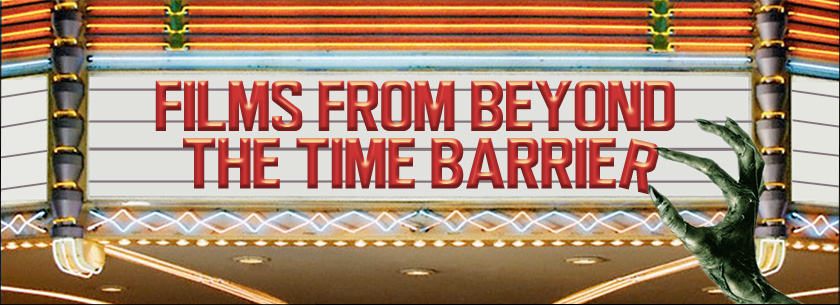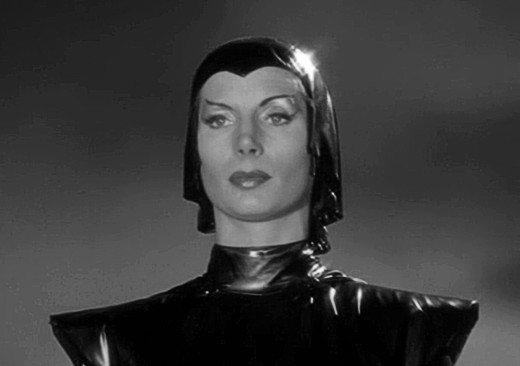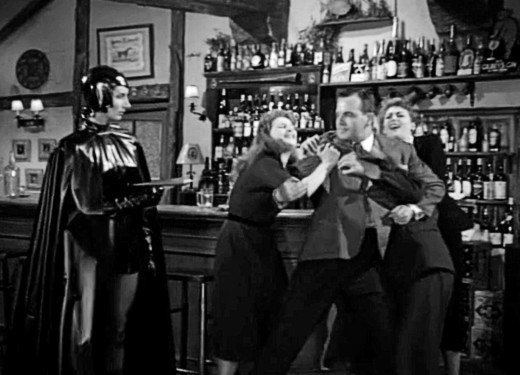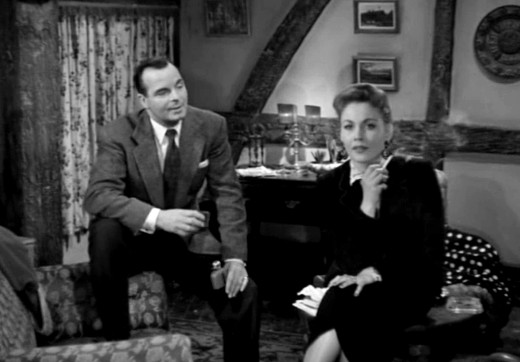Pros: Atmospheric direction and cinematography; Masterful acting
Cons: A false note somewhat spoils the ending
The Flesh and the Fiends tells the grim but true tale of two Irish immigrants living in early 19th century Edinburgh, Scotland who discover that there’s good money to be had supplying the local medical academy with cadavers, but can’t be bothered to dig up the bodies from graveyards like other body snatchers. So they decide to hurry up the dying process in still-breathing neighbors in order to get top dollar (make that guineas) for the freshest possible corpses.
After watching the movie, I Googled to see if cadavers are still being used in medical schools (although I’m visiting the doctor more often as I get older, I’m not exactly well-informed on current medical science ). Surely in 2022, with access to the kind of computing power and virtual reality programs that we have, there’s no more need for actual cadavers?
Well, yes and no (and don’t call me Shirley). According to an article published by the Advisory Board (an organization that provides research and insights to the healthcare industry), the use of cadavers in medical education has been going on for nearly a thousand years. They’re still being used today, but the cost of acquiring, maintaining and ultimately burying donated or unclaimed bodies is becoming prohibitive, and like many things these days, there’s a shortage.
Many schools are switching to virtual reality, which gives students “a more realistic view of living organs,” and allows them to examine the organs from every angle. On the downside, “it can be difficult to develop a depth perception of a virtual body, and students [aren’t] able to see the natural anatomical variations that occur in bodies.” Nevertheless, the article quotes one expert as predicting that cadaver use will be history within ten years. [“Will cadavers in medical schools soon be a thing of the past?” Advisory Board website, https://www.advisory.com/daily-briefing/2019/10/03/cadavers, Oct. 3, 2019]
Back in 1820s Edinburgh where The Flesh and the Fiends is set, the nearest thing to virtual reality was the Magic Lantern, an early forerunner of the slide projector. Anatomy lessons were conducted with real-dead corpses, a lot of them not-so-fresh, and the less said about how they were obtained, the better.
 |
| If only they'd had The Visible Man back then... |
The murderous William Burke and William Hare were well-placed to take advantage of a situation in which the medical sciences were beginning to flourish, but resources like fresh cadavers for the training of doctors were in short supply.
The Flesh and the Fiends is faithful to the main facts of the notorious case (and even to some small details). It was a sort of passion project for John Gilling, who provided the story, co-wrote the screenplay and directed. In the late ‘40s, Gilling wrote the screenplay for The Greed of William Hart (aka Horror Maniacs: 1948), based on Burke and Hare and played for maximum melodrama by lead actor Tod Slaughter.
Censors at the time wouldn’t allow the guilty parties' names to be used, but for some reason did allow a couple of their victims their real names. By 1960, Gilling was able to use the names of all the principal historical figures, but Burke and Hare still couldn’t appear in the film’s title.
While The Greed of William Hart was a melodramatic vehicle for a corny old stage actor and movie villain, Gilling turned the remake into a dark examination of British working class ghettos and rigid class differences in an age that was also characterized by rapid industrialization and progress in the sciences.
One of the stars of the era’s scientific progress was Dr. Robert Knox, who by the time of the Burke and Hare murders was an esteemed member of the Royal Society of Edinburgh who had helped set up a major school of anatomy at the College of Surgeons. He was famous for his frequent and lively lectures and dissection demonstrations.
 |
| Dr. Knox (Peter Cushing) and his assistant "Bones" McCoy lecture to a rapt audience of medical students. |
But the supply of cadavers for his demonstrations was never a sure thing. The law at the time stipulated that only the bodies of those who had died in prison, committed suicide, or were orphans (and presumably dead) could legally be used for such purposes. With such limitations, demand outstripped supply, so Knox and his fellow anatomists turned to body snatchers, also known as resurrection men (or resurrectionists), who took advantage of a loophole in the law: although disturbing a grave or stealing from a body were illegal, actually making off with the body itself was not a crime, since the dead don’t belong to anyone. (Huh.)
The times being what they were, with good, living wages rarer than hen’s teeth, body snatchers nonetheless dug up many a fresh grave, the law be damned. And of course, Dr. Knox and many of his colleagues turned a blind eye to the means by which cadavers ended up on their dissection tables.
Speaking of blind eyes, one of the details of the historical case that The Flesh and the Fiends pays particular attention to is the scarred left eye of Dr. Knox. The real Knox had contracted smallpox as an infant, resulting in a damaged eye and facial scarring. Beyond the obvious symbolism of turning a literal blind eye to what was going on, the disfigurement, which affects only half of the doctor’s face, also reinforces the doctor’s dual, “two-faced” nature; on the one hand, passionately wanting to advance the cause of medical science presumably for the good of all, but at the same time not seeming to care if members of the “lower classes” get hurt in the process.
The Flesh and the Fiend’s Dr. Knox is portrayed by Peter Cushing, who was fresh off of starring roles in Hammer’s game-changing technicolor Gothic horrors The Curse of Frankenstein (1957), Horror of Dracula (1958), and Revenge of Frankenstein (1958). Cushing must have felt a blast of deja vu: with Knox’s tunnel-visioned passion for science, proclivity for cutting up bodies, and blithe indifference to the human costs of his work, the esteemed doctor is a close cousin to Baron Frankenstein.
The similarities between Knox and Dr. “Stein” in The Revenge of Frankenstein are particularly striking. Both are brilliant and charismatic. Knox’s lectures are standing-room only, where the students hang on his every word. Frankenstein, who has reinvented himself as Dr. Stein, is one of his adopted town’s leading citizens, operating a clinic for the poor while simultaneously entertaining the town’s upper crust matrons, who practically swoon over the handsome, urbane doctor.
Both doctors are envied and resented by their parochial colleagues, and in turn, both are openly contemptuous of the small-minded mediocrities who are afraid of change and unwilling to pay the price of progress.
 |
| Dr. Knox schools his unimaginative colleagues on the costs of scientific progress. |
If anything, Knox is more aggressively dismissive of prevailing morality than Revenge’s Frankenstein. In an early scene, Knox defends the practice of body snatching in a debate with a a group of his staid colleagues, including a minister:
Knox: “I tell you gentleman, medicine is being driven underground. The law yields to us the body of a criminal when he is caught and hanged. [W]e have to wait a very long time for justice to unravel itself. Meanwhile, the resurrectionist plies a very useful trade.”
Minister: “I agree you doctors need bodies for dissection, but to condone the violation of graves by these ghouls…”
Knox: “I neither condone or condemn… I accept. Is the feeding of worms more sacred than the pursuit of truth?”
Cushing himself remarked on the similarity of the two characters: “Now it seemed to me that Knox and 'Frankenstein' had a lot in common. The minds of these exceptional men were driven by a single desire: to inquire into the unknown. Ahead of their time, like most great scientists, their work and motives were misunderstood." [Christopher Gullo, In All Sincerity, Peter Cushing, Xlibris, 2016, p. 139]
While The Flesh and the Fiends was not a Hammer production (more on that later), the distributors were not above exploiting Cushing’s new status as a Hammer horror icon and putative monster. In a couple of the film’s posters, Cushing’s/Knox’s face with its deformed left-eye completely dominates the other images. In one (illustrated at the top of the page), his good eye is voyeuristically turned toward an inset image of a woman in working-class attire who is either being menaced or helped -- it’s not clear which -- by a wealthy looking man dressed in a black. In another (below), the face stares menacingly out from the poster, as if sizing up the viewer for possible use on his dissection table.
One could easily be excused for thinking that this is the face of a ghoul for whom (to paraphrase the movie’s tagline) murder is a business. In contrast, the real ghouls, Burke and Hare (played by George Rose and Donald Pleasence respectively), are scarily ordinary, and not given much prominence in the posters.
They start out the movie as a couple of work-averse layabouts with nothing more pressing to think about than the next meal. Burke has middle class pretensions -- he and his wife run a boarding house -- but he’s worried that the meager income may not be enough to stave off the need to do actual **GULP!** work. Hare seems to have no other occupation than to be attached at the hip to Burke, and to proudly sport the latest fashions from the 1820s equivalent of Goodwill.
When an elderly resident at Burke’s boarding house dies on him still owing rent, Hare comes up with the bright idea of selling the body to Knox, which they rationalize as a posthumous way for the old man to settle his debts. The payout is more than the debt, and pretty soon the lure of easy money spurs them to be more proactive and not wait for people to expire naturally.
The real horror is in the casualness with which they dispatch their meal tickets. After they smother a drunk old woman in one of the boarding rooms, Hare doffs his hat in mock mourning: “I’m sure the old girl’s better off. She had nowhere to go… it must be a terrible thing when you’re old…” Burke’s wife (Renee Houston) is no better, keeping watch while the men go about their evil business, and expressing more concern about the tidiness of her house than the murders being committed in it.
 |
| Knox can barely contain his revulsion at having to deal with Burke and Hare. |
The section of Edinburgh in which they live is a rabbit-warren of dark, narrow alleyways and dingy tenements. As the men work their murderous trade, their surroundings become increasingly dark and gloomy, and the shadows the two cast seem like representations of their black souls. With each murder, Hare becomes more animated and boisterous, his eyes positively shining. He is a dancing imp at the side of the slow-witted, ponderous Burke, urging him on. It’s a great performance.
The only relief from the gloom and squalor on the poor side of town is the tavern, which is brightly lit and teeming with people desperately laughing, drinking and carousing. Knox sends his assistant, struggling medical student Chris Jackson (John Cairny), to the tavern to pay Burke and Hare the balance owed from one of their deliveries.
A proverbial fish out of water, Jackson gets himself beaten up trying to defend the honor of one of the tavern girls, beautiful Mary Patterson (Billie Whitelaw). The two are from completely different worlds. Jackson, who is despairing of ever finishing the medical program, finds solace in the arms of the alluring but coarse girl. Mary is flattered by the attention of a real gentleman, but deep down knows that there’s no chance for them.
In a heart-rending scene, Jackson takes Mary out for a stroll in the park, but to his dismay the two run into Knox’s colleague Dr. Geoffrey Mitchell (Dermot Walsh) and Knox’s niece Martha (June Laverick). Mary tries a little too hard to impress, and the smiles and cheer turn to slight frowns and embarrassed silence as class differences become painfully apparent. Back at Mary’s place, she vents her humiliation at Chris, who lamely professes that he is not ashamed of her. Mary is quickly mollified, and turns to what she knows best -- sex -- to smooth things over.
 |
| "I can teach you more than you'll learn at college..." |
WARNING: SPOILERS AHEAD
There is no happy ending for the star-crossed lovers, and by film’s end they’ve paid a very steep price for not staying in their social lanes.
As the evidence mounts that Burke and Hare’s deliveries are a little too fresh, Knox maintains a poker face, only showing his humanity at the very end when it’s impossible to look the other way. It’s maddening from the perspective of a normal, caring human being, but very believable from the standpoint of an obsessed scientist who is all about his work, and Cushing plays it to perfection.
The climax of The Flesh and the Fiends is pure Universal Frankenstein, with torch-carrying townspeople hunting down the monsters through dark, twisting streets. The film’s major false note comes at the very end, when a contrite Knox, having escaped legal judgement and still wanting to pass on his expertise to the next generation of physicians, enters the lecture hall, thinking that it will be empty. Instead, he’s surprised to see it’s filled with appreciative students. Knox is so humbled and inspired, he begins his lecture with Hippocrate’s advice to physicians to “first, do no harm.” (The real Knox did not get off quite so easily. While it's true that in the immediate aftermath of the murders his classes were more popular than ever, his career nonetheless suffered and he was ultimately expelled from the Royal Society and his school was shut down.)
Ugh. Order has been restored, the class system is still firmly in place, and worst of all, an upper class monster is redeemed, while Edinburgh’s poor, when they aren’t murdering one another, are mostly portrayed as scheming, uncaring wretches or members of an unthinking mob. Still, there’s Mary, beautifully played by Billie Whitelaw, who upholds the dignity of the non-privileged classes. While certainly not perfect, she is smart and willing to sacrifice her own happiness and aspirations to try to save Chris Jackson from himself.
 |
| You do not want to attract the attention of these "gentlemen." |
ALL CLEAR FOR SPOILERS
The Flesh and the Fiends rode the Gothic horror renaissance that Hammer jump-started with The Curse of Frankenstein and Horror of Dracula. It was produced by partners Monty Berman and Robert S. Baker, who kept busy in the late '50s making Blood of the Vampire (1958; see the review elsewhere on this site), The Trollenberg Terror (aka The Crawling Eye, 1958) and another horror film ripped from the pages of history, Jack the Ripper (1958).
By 1960, Burke and Hare had inspired, along with The Greed of William Hart, Val Lewton's and Robert Wise’s The Body Snatcher (1945; based on a Robert Louis Stevenson short story that in turn was inspired by the actual events). Since then, two movies titled Burke and Hare have been made, one in 1972 and the other, with Simon Pegg, in 2010. The Doctor and the Devils with Timothy Dalton, Jonathan Pryce and Twiggy (!!) premiered in 1985.
With its skillful direction, atmospheric cinematography and masterful acting (especially Billie Whitelaw, Donald Pleasence and Peter Cushing), The Flesh and the Fiends may be the best of the lot, and it’s certainly one of the UK’s better contributions to Gothic horror cinema of the mid-20th century.
Where to find it: Streaming | DVD / Blu-ray









